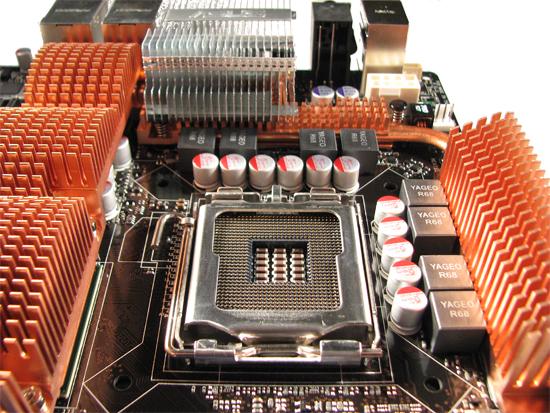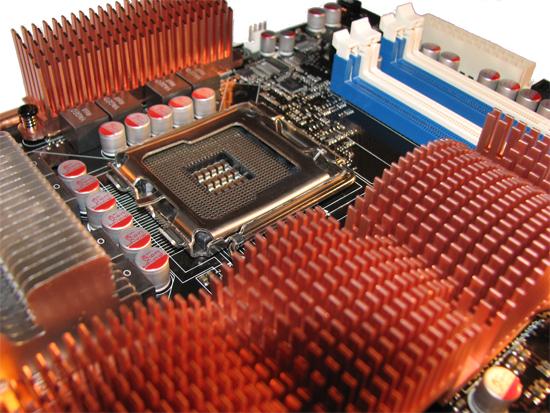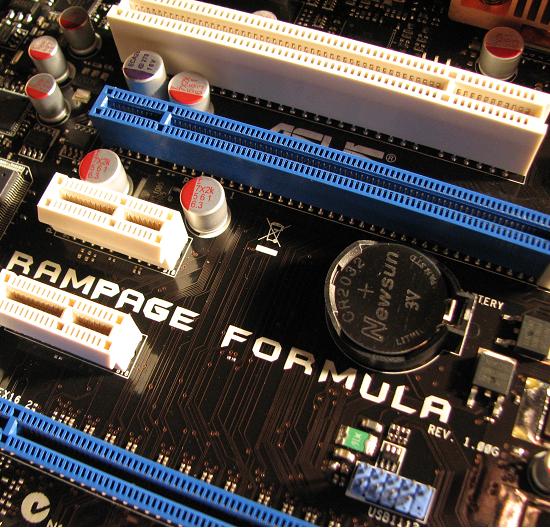ASUS ROG Rampage Formula: Why we were wrong about the Intel X48
by Kris Boughton on January 25, 2008 4:30 AM EST- Posted in
- Motherboards
Board Layout, Features and Specifications


The ASUS Rampage Formula makes use of a beefy 8-phase PWM solution. The copper heatsink covering the MOSFETS is actually not thermally coupled to the Northbridge or the Southbridge as the cooling solution consists of two separate blocks. The hold-down mechanism for the X48's high quality heatsink is comprised of four tension screws attached to a backplate on the opposite side of the board. Besides changing the thermal paste ASUS utilized, we feel there is nothing that needs modification by the end user as long as overclocking aspirations are within reason.


Two full x16 PCI-E 2.0 slots are available for official CrossFire support and the spacing is appropriate. We would have liked an additional PCI slot, for a total of three, instead of the three x1 PCI-E 1.x slots.
Six onboard SATA headers are on the right side of the board, each at 90 degree angles. This made inserting and removing cables easy, even with two full-length video cards installed.
One feature we particularly like is the volt-minder LEDs - one each for the CPU, Northbridge, Southbridge, and memory slots. Each can be one of three colors - green, yellow, or red - and they are useful for determining at a glance the approximate voltage being fed to each component. Green represents "safe" voltages, yellow is elevated (high), and red means "crazy high." Crazy high is just that too, as the board won't set the light red for the CPU voltage until it eclipses about 2.025V.
| ASUS R.O.G. Rampage Formula | |
| Market Segment | Gamer / Extreme Performance - $299.99 (estimated) |
| CPU Interface | Socket T (LGA-775) |
| CPU Support | LGA775-based Core2 Duo, Core2 Extreme, or Core2 Quad recommended, including next-generation 45nm compatibility (06/05B/05A processors) |
| Chipset | Intel X48 Northbridge (MCH) and ICH9R Southbridge |
| CPU Clock Multiplier | 6x ~ 11x, downward adjustable for Core2, upward to 31x for Extreme, half-multiplier support for 45nm processors |
| Front Side Bus Speeds | Auto, 200 ~ 800 in 1MHz increments |
| System Bus Speeds | 1600/1333/1066/800 (MHz) with Official DDR-1066 Support |
| DDR2 Memory Dividers | 1:1, 6:5, 5:4, 4:3, 3:2, 8:5, 5:3, and 2:1 (dependent upon strap setting) |
| FSB Strap | Auto, 200, 266, 333, 400 |
| PCIe Speeds | Auto, 100MHz ~ 180MHz |
| PCI Speeds | Locked at 33.33MHz |
| DRAM Voltage | Auto, 1.80V ~ 3.40V in 0.02V increments, 1.80V standard |
| DRAM CLK/CMD Skew CA/CB | Auto, Manual (Advance/Delay 50ps ~ 350ps in 50ps increments) |
| DRAM Timing Control | Auto, Manual - 20 DRAM Timing Options (tCL, tRCD, tRP, tRAS, tRFC + 15 sub-timings) |
| DRAM Command Rate | Auto, 1N, 2N |
| DRAM Static Read Control | Auto, Enabled, Disabled |
| Ai Clock Twister | Auto, Light, Moderate, Strong |
| Ai Transaction Booster | Auto, Manual |
| Common Performance Level | 1 ~ 31 (settings above 14 prevent POST) |
| CH A/B Phase Pull-In | Based on Memory Divider, All Phases Adjustable (Enabled/Disabled) |
| Core Voltage | Auto, 1.10000 to 1.60000 in 0.00625V increments then 0.05V increments |
| CPU PLL Voltage | Auto, 1.50 ~ 3.00v in 0.02V increments, 1.50V standard |
| FSB Termination Voltage | Auto, 1.20V to 2.00V in 0.02V increments, 1.20V standard |
| North Bridge Voltage | Auto, 1.25V ~ 1.85V in 0.02V increments, 1.25v standard |
| South Bridge Voltage | Auto, 1.050V ~ 1.225V in 0.025V increments, 1.050V standard |
| SB 1.5V Voltage | Auto, 1.50V ~ 2.05V in 0.05V increments, 1.50V standard |
| Loadline Calibration | Auto, Enabled, Disabled |
| CPU Voltage Reference | Auto, x0.63, x0.61, x0.59, x0.57 |
| NB Voltage Reference | Auto, x0.67, x0.63, x0.60, x0.57, x0.56, x0.53, x0.51, x0.49 |
| Memory Slots | Four 240-pin DDR2 DIMM Slots Dual-Channel Configuration Regular Unbuffered, non-ECC DDR2 Memory to 8GB Total |
| Expansion Slots | 2 - PCIe 2.0 x16, Supports ATI CrossFire
Technology 3 - PCIe (1.x) x1, (1) is Compatible with Add-in Audio Card 2 - PCI Slot 2.2 |
| Onboard SATA RAID | 6 SATA 3Gbps Ports - ICH9R (RAID 0, 1, 5, 10) |
| Onboard IDE (PATA) | JMicron JMB368 PATA Controller (up to two UDMA 133/100/66 devices) |
| Onboard USB 2.0/IEEE-1394 | 12 USB 2.0 Ports - (6) I/O Panel - (6) via
Headers 2 IEEE-1394(a) Ports - (1) I/O Panel, (1) via Header |
| Onboard LAN (with Teaming) | Realtek RTL8110SC - PCI Gigabit Ethernet
controller Marvell 88E8056 PCI Express Gigabit Ethernet controller |
| Onboard Audio | ADI 1988B - 8-channel HD Audio CODEC |
| Power Connectors | ATX 24-pin, 8-pin ATX 12V |
| I/O Panel | 1 x PS/2 Keyboard 2 x SPDIF - (1) Optical Out, (1) Coaxial Out 1 x IEEE-1394a 2 x RJ-45 (LAN) 6 x USB 2.0/1.1 1 Clear CMOS Switch |
| Fan Headers | 8 - (1) CPU, (1) Power, (3) Chassis, (3) Optional/Misc. |
| Fan Control | CPU and Chassis Fan Control via BIOS/Extreme Tweaker, PC Probe II monitoring |
| BIOS Revision | v0108 |
| Board Revision | 1.03G |
The ASUS Rampage Formula provides an impressive range of setting specifications. We would go so far as to say that more than a few of these are simply ridiculously high; however, there are sure to be a few people that require these options. A couple of the higher settings to pay attention to: CPU voltage well above 2.0V, CPU PLL voltage to 3.0V (sure to kill your chip super quick), FSB Termination voltage to around 2.0V, and DRAM voltages over 3.4V. While we certainly must commend ASUS on their fine range of control we also feel the need to strongly caution users when working with some of these settings. It's entirely possible to damage or destroy your chipset, CPU, or memory when moving to the extreme limits of these ranges; sometimes less is more.
As we have discussed before Loadline Calibration is best left disabled, especially when using the newer 45nm CPUs. Our testing has shown these settings induce power instabilities, even when using lower voltages. In addition, when enabled the option sometimes requires more CPU voltage than would otherwise be necessary, meaning increased power dissipation and higher temperatures.
Of note, the Rampage Formula allows for half-multiplier usage. This is particularly useful when working in the higher FSB ranges. Because all Core 2 Duo/Quad CPUs are downward unlocked, every half multiplier between the processor default value and 6 can be used, with the exception of 6.5x. For the Extreme processors, this limitation has been relaxed allowing for multipliers as high as 31x in half steps. Besides providing finer CPU frequency control, half-multipliers permit a wider choice of final multiplier/FSB combinations, which can help when choosing the best operating point for the processor and memory. Now that we have experienced what these new values have to offer, it will be hard to work with anything else.
As we pointed out before, "Ai Transaction Booster" is completely revamped for this board series. Setting this option to manual allows the user to take full control of the "Common Performance Level", meaning that all memory phases will baseline at the value as set. Each individual phase can then be "pulled-in" or left as is. "Pulling-in" a phase reduces just that phase's associated tRD value (performance level) by one. Like memory timings, lower values are tighter and thus provide better memory read performance and lower latencies. If all phases are pulled-in, this is the equivalent of selecting the next lower common performance level and performs identically to this new setting. Thus, pulling-in particular phases can allow the user to affect a minor performance improvement if selecting the next lower common performance level is not possible.










73 Comments
View All Comments
Bozo Galora - Friday, January 25, 2008 - link
Yet another world class article by Mr. BoughtonNot only do you give the insight, but you make it easily UNDERSTANDABLE.
You da man
AndyKH - Friday, January 25, 2008 - link
Also... is this tRD adjustment only possible with a X48 board? If not, I would have preferred that this article was kept seperate from an article about a specific motherboard. Don't get me wrong, I think it is a very informative article :-).If it is possible to adjust the tRD on other chipsets than the X48, can the possibility of setting the tRD as low as 5 then be attributed to the X48?
Gary Key - Friday, January 25, 2008 - link
tRD functionality within the BIOS is dependent upon the motherboard manufacturer. We have been harping on the motherboard suppliers to fully open up the BIOS on the enthusiast boards, this includes tRD and associated phase changes. ASUS is one of the first (DFI also) to offer an extensive range of settings in this particular area (most BIOS releases handle tRD adjustments automatically). We debated on separating the article content but due to the BIOS options available, they were more or less tied to each other. Yes, if tRD is available in the BIOS, it can be set on other Intel based boards or chipsets. In fact, I had very good success on the ASUS 780i board with tRD adjustments. Thanks for the comments! :)Georgeisdead - Wednesday, February 27, 2008 - link
Would tRD be called something else? Perhaps Read to Write Delay (tRWD)? I have an EVGA 680i board and I cannot find the tRD setting. I don't even see it as an available option with memset 3.4. Does anyone know of a synonym for tRD?Brunnis - Friday, January 25, 2008 - link
The Gigabyte GA-P35-DS3 has a BIOS option to set tRD and I seem to remember that it had a large effect on memory performance. Would this be the setting that you talk about here. If it is, it seems ASUS isn't the first one to offer it.Shoal07 - Friday, January 25, 2008 - link
Can anyone confirm you can set the tRD to anything besides innoculous settings like "auto" "high" and "low" on the GA-P35-DS3, and specify if its the L or R? Also, what memory was used in this test? (I read the whole article and I don't recall the specs of the system/testbed as a whole).Brunnis - Friday, January 25, 2008 - link
I have checked my GA-P35-DS3 again. The option is labeled "Static tRead Value" in the BIOS and can be set to any integer value between 1 and 31. Modifying this value changes the "Performance Level" as reported by the Windows program MemSet 3.4 accordingly. Changing the value from 8 to 7 on my board yielded the following results in Sisoft Sandra bandwidth benchmark:tRD 7: 7117 / 7139 (MB/s)
trD 8: 7026 / 7045 (MB/s)
Pretty large different from changing a single timing one step.
AndyKH - Friday, January 25, 2008 - link
Is it correctly understood that no other motherboards allow the tRD to be adjusted from within the BIOS, or is it simply because this board has named the setting something sensible? I think the article is a bit unclear about that.legoman666 - Friday, January 25, 2008 - link
Very enlightening article. The only thing missing are real world application tests showing the benefits in office applications, games (most important ;) ), and encoding.Gary Key - Friday, January 25, 2008 - link
We will have full application benchmarks in the X48 roundup that Kris and Raja are working on.